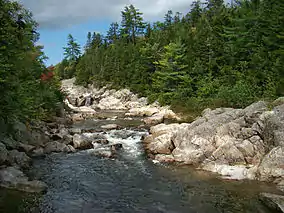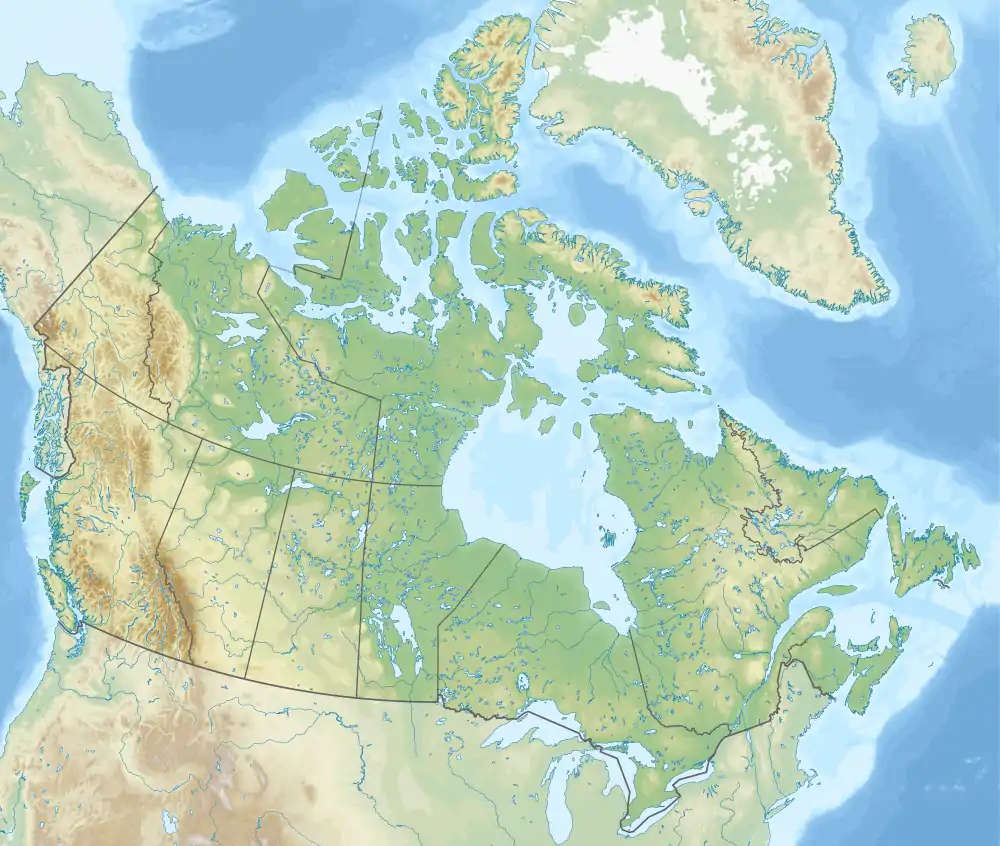Fundy National Park
Fundy National Park is a national park of Canada located on the Bay of Fundy, near the village of Alma, New Brunswick. It was officially opened on 29 July 1950. The Park showcases a rugged coastline which rises up to the Canadian Highlands, the highest tides in the world and more than 25 waterfalls. The Park covers an area of 207 km2 (80 sq mi) along Goose Bay, the northwestern branch of the Bay of Fundy. When one looks across the Bay, one can see the northern Nova Scotia coast.
| Fundy National Park Parc national de Fundy (French) | |
|---|---|
IUCN category II (national park) | |
 The Moosehorn Trail | |
 Location of Fundy National Park in Canada  Location of Fundy National Park in New Brunswick | |
| Location | Alma, New Brunswick, Canada |
| Coordinates | 45°35′43″N 64°57′14″W |
| Area | 207 km2 (80 sq mi) |
| Established | 1948 |
| Visitors | 281,289[1] (in 2015–16) |
| Governing body | Parks Canada |
At low tide, park visitors can explore the ocean floor where a variety of sea creatures (e.g., dog whelk, periwinkles, various seaweeds) cling to life. At high tide, the ocean floor disappears under 15 m (50 ft)of salt water.
There are 25 hiking trails throughout the park. The Caribou Plains trail and boardwalk provides access to upland forest and bog habitats. Dickson Falls is the most popular trail in the park.
Park amenities include a golf course, a heated saltwater swimming pool, three campgrounds, and a network of over 100 km of hiking and biking trails.[2] During the winter, Fundy National Park is available for day use, at one's own risk. Visitors use the park to go cross-country skiing, snowshoeing, tobogganing, and winter walking. The cross-country ski trails are groomed by the local Chignecto Ski Club.
A variety of scientific projects are ongoing in the Park, with the primary focus on monitoring the park's ecology. Recent projects have focused on re-establishing aquatic connectivity in the park (Bennett Lake Dam, new Culverts, Dickson Brook restoration. Species such as the endangered Inner Bay of Fundy Salmon, Martens and Fishers (members of the weasel family), brook trout, eel, and moose are monitored regularly.
The Dobson Trail and Fundy Footpath extend out of the park to Riverview and to St. Martins respectively. A unique red-painted covered bridge is located at Point Wolfe.
Other rivers that flow through the park include the:
- Broad River
- Point Wolfe River
- Upper Salmon River
Natural environment
According to the Commission for Environmental Cooperation, the park is located in the Level III- Eastern Temperate Forests (Maine-New Brunswick Plains and Hills) ecoregion.[3] According to the Ecological Framework of Canada, the park is situated in two distinct ecoregions.[4] The southern section of the park falls in the Fundy Coast ecoregion.[4] This region experiences cool, wet summers and mild, rainy winters.[5] Its coniferous forest consists of red spruce, balsam fir, and red maple with some white spruce, and white and yellow birch.[5] Some sugar maple and beech trees are also found here at higher elevations.[5] The northern section of the park falls in the Southern New Brunswick Uplands ecoregion.[4] This ecoregion experiences summers that are warm and rainy, and winters that are mild and snowy.[6] Its mixed-wood forest contains mainly sugar and red maple, white and red spruce and balsam fir trees.[6] Finally, according to the World Wide Fund for Nature the park is located in the New England-Acadian forest ecoregion.[7]
The park is home to 658 species of vascular plants, 276 species of bryophytes, and more than 400 species of lichens.[8] The Fundy forest is generally a mixed-wood forest composed of red spruce (Picea rubens), balsam fir (Abies balsamea), yellow birch (Betula alleghaniensis), white birch (Betulla papyrifera), sugar maple (Acer saccharum), and red maple (Acer rubrum). The mixed-wood forest floor is blanketed with moss, wood fern (Dryopteris), and bunchberry (Cornus canadensis).[8]
Pure hardwood stands (distinguishable communities of tree species within a forest)[9] account for 5.4% of the Fundy forest cover.[8] The most abundant pure hardwood stands are yellow birch (Betula alleghaniensis) and white birch (Betulla papyrifera).[8] There are also some sugar maple (Acer saccharum), red maple (Acer rubrum), and beech (Fagus) stands.[8] Carolina springbeauty (Claytonia caroliniana) and trout-lily (Erythronium americanum) bloom in the hardwood forest every year.[8]
The coniferous forest in the park represents the boreal element of Fundy’s forest cover.[8] Although pure stands of conifer are rare in the park, the Fundy forest has some of the last pure stands of red spruce (Picea rubens) found in eastern North America.[8]
The bogs of the park are blanketed with sphagnum moss (Sphagnum) from which grow black spruce (Picea mariana) and Eastern larch (Larix laricina).[10] Within the park’s Caribou Plain bog, three carnivorous plant species are found: pitcher plant (Sarracenia purpurea), sundew (Drosera anglica), and bladderwort (Utricularia).[10]
Some rare plant species are also found in the park.[11] Bird’s-eye primrose (Primula farinosa) is found along the Point Wolfe and Goose River coastal cliffs, and several other rare flora species, namely slender spikemoss (Selaginella viridissima), squashberry (Viburnum edule), green spleenwort (Asplenium viride), rare sedges, and fir clubmoss (Huperzia selago), are found along the eastern branch of the Point Wolfe River and the lower part of Bennett Brook.[11]
Fauna
Animals that inhabit this national park are moose, snowshoe hares, chipmunks, cormorants, red squirrels, pileated woodpeckers, little brown bats, peregrine falcons, black bears, coyotes, beavers, white-tailed deer, white-winged crossbills, various mice and shrews, juncos, sandpipers, raccoons, warblers, plovers, great blue herons, and northern flying squirrels.
Tourism and administration
Located in Alma, New Brunswick, Fundy National Park is operated by Parks Canada an agency of the Government of Canada that is managed by Environment Canada.[12] For the 2013-2014 fiscal year, Parks Canada plans to spend $693.7 million to manage its 44 national parks, 964 places of national historic significance, and 4 national marine conservation areas.[13] Of these national historic sites, 167 are directly administered by Parks Canada.[14]
Attendance
The park received 240,481 visitors during the 2012-2013 year; a decrease of 7% compared to 2011-2012.[15] It is the most visited Parks Canada site in New Brunswick.[15] Data from previous years reveal that 40% of people who camped at the park were from New Brunswick, 8% were from Nova Scotia or Prince Edward Island, and 52% were from outside the Maritimes.[16] In 2005, visitors from outside of the Maritimes were 59% adult couples and 29% families; while visitors from the Maritimes were 67% families and 24% adult couples.[16]
See also
| Wikimedia Commons has media related to Fundy National Park. |
- National Parks of Canada
- List of parks in New Brunswick
- List of trails in New Brunswick
- List of mountains of New Brunswick
- List of waterfalls of New Brunswick
- List of beaches in New Brunswick
References
- Parks Canada Visitation Records Accessed November 17, 2016
- "Natural Wonders & Cultural Treasures". Fundy National Park of Canada. Retrieved 2007-07-29.
- "North American Terrestrial Ecoregions - Level III" (PDF). 3.cec.org. April 2011. Retrieved 2015-08-12.
- "Atlantic Maritime Ecozone". Ecozones.ca. Retrieved 2015-08-12.
- "Ecoregion: FUNDY COAST". Ecozones.ca. Retrieved 2015-08-12.
- "Ecoregion: Southern New Brunswick Uplands". Ecozones.ca. Retrieved 2015-08-12.
- "New England-Acadian forests | Ecoregions | WWF". Worldwildlife.org. Retrieved 2015-08-12.
- "Parks Canada - Fundy National Park - Caledonia Highlands Plateau". Pc.gc.ca. 2014-05-15. Retrieved 2015-08-12.
- "stand [46 records] - TERMIUM Plus® — Search - TERMIUM Plus®". Btb.termiumplus.gc.ca. Retrieved 2015-08-12.
- "Parks Canada - Fundy National Park - Caledonia Highlands Plateau". Pc.gc.ca. 2014-05-15. Retrieved 2015-08-12.
- "Parks Canada - Fundy National Park - Park Management". Pc.gc.ca. 2014-03-25. Retrieved 2015-08-12.
- "Parks Canada - Fundy National Park". Pc.gc.ca. 2015-06-26. Retrieved 2015-08-12.
- "Parks Canada - Section I - Organizational Overview - Section I: Organizational Overview". Pc.gc.ca. 2013-03-28. Archived from the original on 2016-03-04. Retrieved 2015-08-12.
- "Parks Canada - National Historic Sites - National Historic Sites". Pc.gc.ca. 2015-07-28. Archived from the original on 2015-09-21. Retrieved 2015-08-12.
- "Parks Canada - Parks Canada Attendance 2009-10 to 2013-14 - National Parks, Park Reserves, & Marine Conservation Areas". Pc.gc.ca. 2014-07-11. Retrieved 2015-08-12.
- "Parks Canada - Fundy National Park of Canada - Management Plan - November 2005 - Fundy National Park of Canada - Management Plan". Pc.gc.ca. 2011-06-07. Archived from the original on 2016-03-04. Retrieved 2015-08-12.
- "Provincial Archives of New Brunswick". Archives.gnb.ca. Retrieved 2015-08-12.
Gallery
 Dickson Falls
Dickson Falls Alma Beach at low tide
Alma Beach at low tide Point Wolfe
Point Wolfe Dickson Falls
Dickson Falls Laverty Falls
Laverty Falls Headquarters of Fundy National Park
Headquarters of Fundy National Park